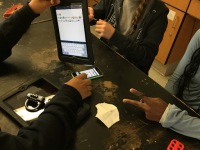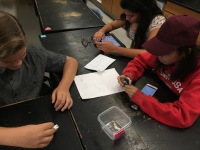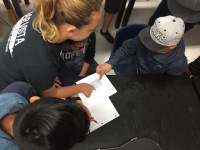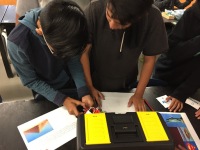I ran my first BreakoutEDU game with my 7th grade science students last February. It was an incredible experience for my students and me; even though they didn’t break out, we had a great debrief and were able to critically look at the skills needed for perseverance and problem solving.
In March, Justin Birckbichler and I started building digital versions of the breakouts, which ended up being quite the project. We found that many teachers struggle with the productive struggle just as much as our students, and we put great value on teachers modeling the critical thinking process alongside their students. In order to ensure more flexible and resilient adults in the future, we must explicitly teach and model these skills for our students.
 |
| Double checking math clues. |
Fast forward to now, my 8th grade AVID students just finished creating their own Breakout EDU games! They used what they learned in their career research project within their game. It was a very challenging process for both myself and my students–just like when I facilitate games, I did not step in to help them more than absolutely necessary. In other words, I allowed some of their clues to fail. Why? That’s where the learning takes place!
 |
| Using emoji rebus to create a riddle |
The setup
My students had already played a few physical and digital games, and were familiar with the skills needed to successfully play Breakout EDU games. They were excited about creating their own games, and we talked about what elements make a successful game (story hook, interesting topics, clues that are not too hard but not too easy), then they launched into their game building.
 |
| Brainstorming clues based on available locks |
2. Students wrote their story in their group’s shared planning Doc (before they received their locks)
3. I gave each group a basket with 4-5 locks. Students decided who would create the clue for each lock.
4. Students created their clues on shared Slides.
5. I programmed all the locks and printed the clues.
I programmed the locks ahead of time based on students’ planning docs, and had each set of locks separated and ready to go.
Each team facilitated their own game. I had them fill out a reflection graphic organizer as their peers played their game. This served two purposes: it kept the facilitators busy so they didn’t become too vocal and it allowed students to reflect on the process of designing and facilitating their own game.
It was incredible to step back and watch my students play and facilitate their own groups. Some students tried to ask me about specific clues during the game, and I directed them to ask the game creators. It did not go perfectly, and some of the clues were confusing, but that’s all part of the learning process!
 |
| Finding area of an shape to solve a clue |
 |
| “I think I have it!” |
One group particularly struggled with designing their game. They lacked teamwork and cohesion, and it showed in their final product. While playing, they realized that one of their clues made no sense to their participants: it was a math problem, but the resulting code was random numbers from that math problem. It was SO hard for me to not jump in and rework their clue to make sense. I had them go outside to discuss how they could change their clue on the fly, then come back in and give the participants a hint. They had to go back outside multiple times before they had a solution. The whole process took over 10 minutes, and many failed attempts of guiding questions from the facilitators to their peers. It stretched their brains, but it also taught my students how to think on their feet.
The debrief
We had great discussions after playing the games. Students shared what they found was successful, challenging, and what they learned about themselves in the process. We focused on the positives and constructive feedback, and how we can learn from this.
Additionally, we used our school’s character qualities, the Vikings’ Code, to write blog posts on our experiences:
Use at least 3 characteristics from the Vikings’ Code to answer the following questions. Remember to use specific examples in your writing!
– Describe your experience designing your own Breakout EDU game.
– Describe your experience facilitating the game you created.
– Describe your experience playing your peers’ games.
 |
| Filling out facilitator feedback graphic organizer while peers play. |
If I had a dollar for every time a student said “Ms. V, this is hard!” during the game creation process, I’d be rich! I knew this process would be tough, but I didn’t anticipate how much we would all learn. The formal and informal debrief conversations brought out many great ideas and learning opportunities.
– My students wished they had a chance to test out their games before their peers played. In the future, we will build in a peer review process within the game design.
– Students quickly realized that creating critical thinking opportunities is significantly more difficult than critically thinking itself.
– As hard as it is to step back as a game facilitator, it’s even harder to step back while students are designing and facilitating their own games. They have to experience the highs and lows themselves, without me stepping in to fix everything.
Next steps
My students are excited to share their games via another teacher at the AVID National Conference in December. They are revising their games, testing them out on teachers and students at school, then submitting a final draft game.
Students will have another chance to build a game in the spring, and this time we’ll open it up to physical or digital games…content or purpose to be determined.
